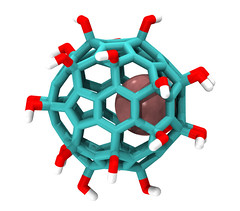Biologists have long known cancer cells spread through the
body, but not on exactly how they spread, and how to inhibit them at a molecular
level. Working with an international team of cell biologists, chemists, and
computational biologists, IBM Research scientist Drs. Ruhong Zhou, Seung-gu
Kang and Tien Huynh, have shown in simulations that nanoparticle gadolinium
metallofullerenol (
Gd@C82(OH)22)
prevents the spread of pancreatic cancer cells by quarantining them (see animation). It binds
to and blocks the enzyme responsible for tumor metastasis and survival.
Earlier this year, the team from China led by Prof. Yuliang
Zhao of the China National Center for Nanoscience and Technology discovered
that the metallofullerenol could bind to breast cancer and stop its metastasis,
but did not know how it happened at a molecular level. IBM's work, featured in September’s
Proceedings of the National Academy of Sciences, reveals for the first
time the molecular mechanism of this process. Gadolinium
metallofullerenol acts as a nanomedicine via inhibition of the cancer-instigating
matrix metalloproteinase enzymes (MMPs).
Finding cancer’s
“off” switch
MMPs degrade the extracelluar matrix (ECM) that confines cancer
cells and spurs blood vessel growth into the cancer cells. So, these enzymes not
only help tumors grow and spread in the body, but also keep them healthy. Stopping
this cycle was a three-fold challenge:
- Find the
right MMP(s) (we have 27 MMPs in our bodies)
- Stop
those MMPs’ capability to spread the tumor
- Stop
those MMPs’ capability to feed the tumor
The China National Center for Nanoscience and
Technology team's experiments show that MMP9 is the most affected of these enzymes by metallofullerenol at a cellular level. IBM's team ran molecular dynamics simulations for a few months on a Blue Gene supercomputer and
found that gadolinium
metallofullerenol inactivates the function of MMP9
through an exocite binding mode near its S1’ loop, which is responsible for ligand (molecular binding point)
recognition.
Knowing how to block this exocite binding mode could provide a new route for future cancer drug
development. Now, IBM is looking at the MMP2 enzyme (which also was also
affected in experiments) for further validation of this novel molecular inhibition
mechanism.
Gadolinium metallofullerenol is found to inhibit
pancreatic tumor growth by about 50 percent. Similarly, it shows more than 80 percent inhibition rate to metastasis of human breast cancer in
previous work (Nanomedicine 8, 136-146, February 2012). These
findings may provide a new route of development of specific MMP inhibitors and
effective anti-cancer nanomedicine.
IBM’s collaborators will soon begin producing these
nanoparticles for phase one clinical trials. While a commercial drug is still a
few years away, this is the first time we’ve understood and shown how to effectively
attack cancer cells with a nanoparticle.
IBM’s Computational
Biology Center collaborated with the China National Center for Nanoscience and
Technology in Beijing; the Environmental Molecular Sciences Laboratory at the
Pacific Northwest National Lab, in Richland, Washington; and the Department of
Chemistry at Columbia University.
Labels: cancer treatment, nanomedicine, nanotechnology
